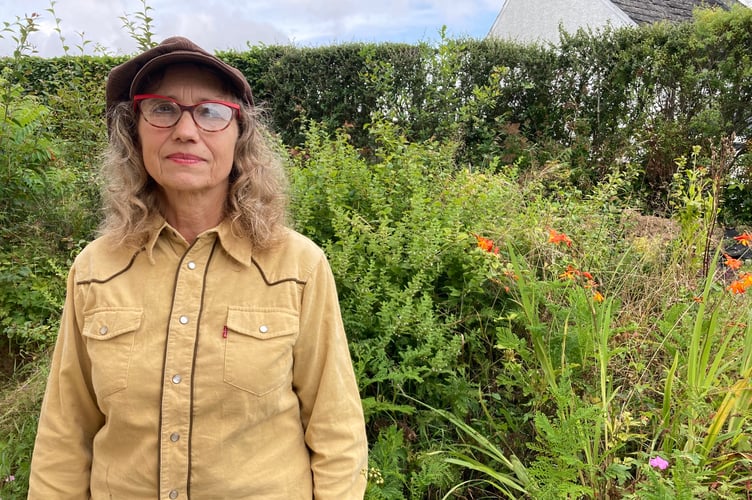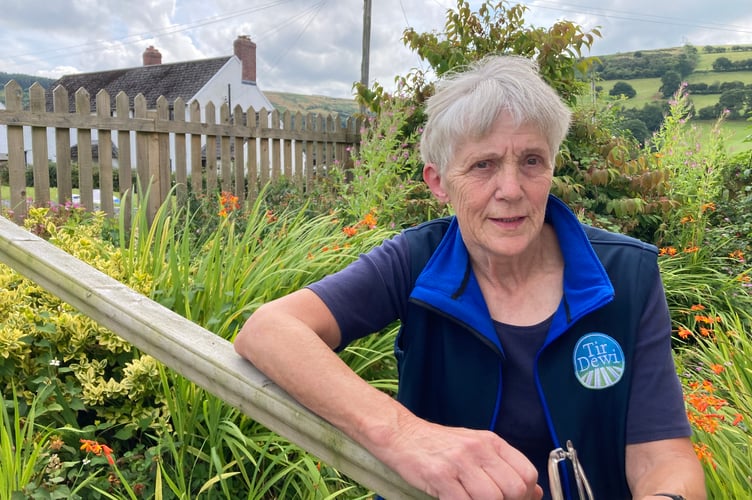Residents of a Carmarthenshire village have expressed varied opinions on the proposed state-backed wind farm in Brechfa forest.
A sign on the edge of Abergorlech declares it was the best kept village in Carmarthenshire for four years between 1964 and 1970, a time when the vast majority of the UK’s electricity was generated by burning coal.
Abergorlech, by Brechfa Forest, still looks a picture – resident Patrick Brotherton described it as “a paradise” – but when it comes to electricity the times they are a-changin’, as Bob Dylan sang in his 1964 album of that name.
A privately-owned wind farm operates on the western side of Brechfa Forest, which is popular with walkers, horse riders and mountain bikers, and now 27 turbines have been proposed by a publicly-owned company in Wales, Trydan Gwyrdd Cymru.
A map indicating where this new Glyn Cothi wind farm would be located shows the majority of the turbines in the central and eastern section of the Welsh Government-owned woodland in the hills above Abergorlech. There is also a wind farm, Alltwalis, on land west of Brechfa Forest.
Trydan Gwyrdd Cymru announced plans early in July for three state-backed wind farms in Wales, and talking to people in Abergorlech and nearby Brechfa about the Glyn Cothi one, views are mixed.
The Reverend Canon Delyth Wilson, of Abergorlech, said: “We seem to be bombarded in this beautiful part of Wales by these turbines. I am keen that we are more sustainable, but these things are going to be really high. I don’t think that we will see them, but I don’t know if we will hear them.

“And how are they are they going to get them here on these tiny roads? That is perhaps my main concern.”
Trydan Gwyrdd Cymru is proposing to run a wire from the wind farm on wooden poles to a new substation planned near Llandyfaelog, between Carmarthen and Kidwelly, and Mrs Wilson wondered if the route would follow the Cothi Valley. “The Cothi Valley is a gem,” she said.
When Trydan Gwyrdd Cymru was launched last summer, Economy Secretary Jeremy Miles said it would generate significant returns for people in Wales – energy projects have often led to profits going to foreign companies. Richard Evans, chief executive of Trydan Gwyrdd Cymru, said the renewable sector would need to “visibly embed benefits into local communities”.
Wind farms have community benefit schemes which parcel out grants to local projects. According to Mrs Wilson, the existing Brechfa wind farm has “thrown money at Brechfa but not us” and that, in her view, subsidising local residents’ electricity bills would make more sense as a benefit.
The 72-year-old also said she had tried to install solar panels on her home but hadn’t been able to because she lived in a designated conservation area. “Now they’re going to have these turbines behind us,” she said.
Her husband, Paul, said he had never really noticed the turbines already in place in Brechfa Forest. Referring to the Glyn Cothi wind farm proposal, he said: “As long as they are reasonably out of sight then I would not mind them at all. If we are going to have them, I think it’s only reasonable that we could benefit from them. I think everybody would say that.”
A few doors down, Mr Brotherton said he didn’t know that much about the project, but added that “a few people are really up in arms about it”.
He said Abergorlech was “a paradise”, so would he be upset if the wind farm was built? “I don’t think so,” he said. “It’s the future. And would it make a difference if we did complain? I believe it’s definitely going to happen – I’ve been in this world long enough.”
In Brechfa, four miles to the south west, Mari Mitchell said siting concrete foundations, tracks and turbines in a woodland ran counter to the Welsh Government’s National Forest for Wales plan, which aims to develop a network of woodlands the length and breadth of the county.
In her view it also jarred with requirements for farmers to have tree cover on 10% of their land as part of a subsidy scheme – a move which sparked protests and changes to the scheme that’s now due to launch in 2026.
Mrs Mitchell said she did not oppose wind turbines in general but was worried about their impact on wildlife and what she claimed was ancient woodland in the area of Brechfa Forest where the Glyn Cothi turbines were proposed.
“We are leaving a legacy to future generations of vast concrete foundations and carbon fibre blades which can’t be recycled,” she said.

Trydan Gwyrdd Cymru said there weren’t any ancient trees in Brechfa Forest, and that planning permission for wind farms included details on how they would be decommissioned. It said foundations tended to be left in situ as excavating them could be more harmful and that many elements of a wind farm could be recycled or reused. Mrs Mitchell maintained there were “hard woods” towards the east of the forest.
Jillie Gardiner said she moved to Brechfa 24 years ago because of the open access land and opportunities for horse riding. She has two horses and a pony, and also used grants to develop a bunkhouse for visitors.
She felt the Glyn Cothi plan would undermine decades of work to build up the Brechfa Forest’s tourist appeal and, based on feedback from visitors locally, put them off from coming. Any loss of open access would be a major concern for her.
“This is a case of a wind farm being sited in the wrong location,” she said. “If it was put on private land, that’s completely different.”
According to Trydan Gwyrdd Cymru, there was no conclusive evidence to indicate that wind farms had an adverse impact on tourism, and that should the Glyn Cothi project proceed it would enhance access for walkers, runners, cyclists and horse riding.
Sarah Eyles, who lives in Llanfihangel-ar-Arth, north-west of the Brechfa Forest, said she objected to the scale of projects known as developments of national significance like Glyn Cothi and claimed people had very little say in them.
She said she could see the Alltwalis wind turbines from her home and that the ones planned at Glyn Cothi would be considerably higher. “They’re completely out of proportion to the area,” she said. “People will see them from a very, very long way – they will dominate the landscape.”

Ms Eyles was also worried about noise made by turbines, light disturbance known as flicker, impact on habit, biodiversity and tourism, and the potential outsourcing of jobs to deliver the Glyn Cothi wind farm. “For all these reasons it’s a very bad idea,” she said. For her, developing what would be more expensive wind-generating capacity offshore would be a worthwhile trade-off.
Trydan Gwyrdd Cymru said the proposed wind farm aimed to strike the right balance between optimising electricity generation, which larger turbines did, and being sensitive to the local environment. Modern turbines of 200 metres-plus could generate significant amounts of power, it said, but the the scale of the Glyn Cothi ones would be determined through stakeholder engagement and environmental and technical assessments.
Trydan Gwyrdd Cymru said it would also rigorously examine existing habitats and species at the commercially-run forestry to ensure it knew how to avoid any potential impacts. Birds surveys, it said, would be conducted over two years. The company added that it would look to improve habitats a bit further away from the planned infrastructure, such as replanting conifers with other tree species, particularly broad-leaf ones.
Leah Dee, of Gwernogle, north of Brechfa, said being able to see the existing Brechfa Forest turbines, and being aware of another plan for a wind farm, hadn’t deterred her from buying her house a few years ago.
She backed the production of green energy but she did have worries about the potential size of the Glyn Cothi turbines and the disruption if it was built. “We just don’t know,” she said. “If we saw benefits in the local area then people perhaps wouldn’t be so upset about it.”

Around 80% of people in the UK support or strongly support renewable energy, according to data published this spring by the Department for Energy Security and Net Zero, although people in Wales were among the least likely to show strong support.
Support specifically for onshore wind was around 73% in the UK, but only 37% said they would be happy for a wind farm to be built in their local area.
The UK’s move away from coal and oil in the production of electricity in recent decades has been an environmental success story. In 2024 just over 50% of the UK’s electricity was generated by renewable schemes, a 4% rise on the previous year. But there is more to do to meet legally-binding environmental targets.
The transition away from large fossil fuel-powered plants has cut the greenhouse gas emissions which contribute to the warming of the planet, but a larger number of distributed power sources like wind farms – often in less populated areas – requires more substations and pylons and also measures to smooth out their intermittency so that supply matches demand. The Glyn Cothi proposal includes battery storage to hold and release electricity generated at appropriate times.
The Welsh Government wants 100% of Wales’ electricity needs to be met by renewable sources by 2035, and demand for electricity is rising as transport and heating systems start to go electric and power-hungry data centres are rolled out.
Trydan Gwyrdd Cymru said the Glyn Cothi wind farm was expected to generate the equivalent electricity used by 144,000 households, which factored in intermittent wind speeds rather than an unachievable consistent wind blowing 24 hours a day.
It said it would have to go through the same consenting process as any other developer despite being Welsh Government-owned. The intention at this stage is to submit a planning application early in 2027, it said, and if permission is granted by Welsh ministers, to start work after 2030.
The company’s development director, Simon Morgan, stressed the proposed Glyn Cothi wind farm was in a commercial timber forest.
“Trydan propose to either ‘keyhole’ (cut) around turbine locations – removing just a very small area of trees – or schedule the turbine installation to coincide with planned felling cycles,” he said.
Mr Morgan said it would seek to enhance recreational access, and improve biodiversity at appropriate places within the wider forest. Public engagement, he said, would start this autumn. “We look forward to lots of face-to-face, evidence-based conversations,” he said.
The Local Democracy Reporting Service contacted the Welsh Government to ask if it wanted to comment, but it declined.
People in Abergorlech and Brechfa seemed to have a genuine affection for and tie to their landscape, which was badly impacted by Storm Darragh last December, resulting in several forest trails becoming inaccessible. Natural Resources Wales, which manages the woodland, said visitors should check its website for up-to-date information.

Whether more Brechfa Forest wind turbines would negatively impact the local tourist economy remains to be seen.
Keen mountain biker Sam Ralton said he didn’t think a wind farm would deter mountain bikers from visiting. “It’s not going to put people off,” he said. “If the trails are good enough and the riding is good enough, that’s what makes a difference.”
Mr Ralton, the owner of Friction Cycles, Bristol, said he had ridden trails all over Wales including at Brechfa, but he could see why people living close to planned wind farms would have mixed feelings.
“If you’ve had views of the forest of course you might be upset about it,” he said. “I can see both sides of the story.”
Andrew Morgan, chairman of Swansea Ramblers, said the key thing for walkers was access to the countryside and good-quality walks.
“If a wind farm negatively impacted on access and rights of way then obviously we wouldn’t be happy with that,” he said. “I don’t think there would be many people who would be deterred as long as they could still go out and enjoy the natural environment.”





Comments
This article has no comments yet. Be the first to leave a comment.